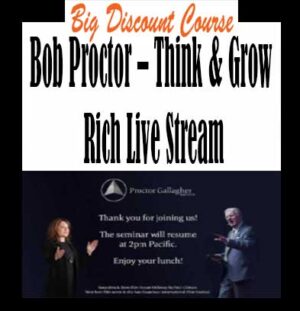Description
David-Dorian Ross – Martial Arts for Your Mind and Body download, David-Dorian Ross – Martial Arts for Your Mind and Body review, David-Dorian Ross – Martial Arts for Your Mind and Body free
David-Dorian Ross – Martial Arts for Your Mind and Body
Martial Arts for Your Mind and Body
Everybody was kung fu fighting … or taekwondo fighting. Or krav maga fighting.
LESSON (25)
01:Strengthen Your Mind, Balance Your Body
Open with five-time world champion Kathy Long in a brief warm-up demonstration, after which David-Dorian Ross leads your first lesson, with an overview of martial arts and some fundamental moves. Although there are many styles, martial arts all rely on our hands and feet as weapons. Explore a few basic techniques and stances broadly common to all forms….
02:Karate: Fighting Stance and Mobility
Step into what may seem like the quintessential Japanese martial art, with its emphasis on powerful physical techniques, from punches and chops to how to train your legs. Join U.S. Olymic team, Sensei Akira Fukuda in this introduction to karate and its history. Learn the fighting stance, the front kick, and a series of punches….
03:Karate: Anticipate but Never Strike First
Reflect on karate’s philosophy of “never strike first†and the implication that you must be able to anticipate and counter your opponent’s move. After a survey of defense and counter-attack concepts, Sensei Fukuda teaches a class around the anticipatory skill levels of “Sen no Sen,†“Go no Sen,†and “Sen Sen no Sen.â€â€¦
04:Karate: End the Fight with a Single Blow
Round out your study of karate’s “empty hand†with an overview of a karate “kata.†Find out how practicing the kata can help you perfect your techniques and strengthen your body and mind. Sensei Fukuda demonstrates the Shiho Zuki (punching in four directions), and Master Ross breaks down the techniques so you can participate….
05:Tai Chi Solo: Find Your Flow
While many of the martial arts in this course are about speed, strength, and intensity, tai chi is known for the fundamental idea that “softness overcomes hardness.†Here, Master Ross introduces you to the history and philosophy that underlies tai chi, as well as the importance and practice of “flow.â€â€¦
06:Tae Kwon Do: Power Is Speed plus Intensity
Although it didn’t officially emerge until the early 1950s, tae kwon do has already become one of the world’s most popular and commercially successful combat sports. Known for lighting fast, head-high kicking style, there is much more to this fascinating martial art. Here, Grandmaster Dave Wheaton teaches the horse stance and introductory kicks….
07:Tae Kwon Do: Seeking Perfection of Form
Like the karate kata, the tae kwon do forms-or “poomseâ€-are the key to practicing technique. After Master Ross introduces these patterns of attack and defense, Grandmaster Wheaton leads you through the first poomse, Chun-ji, which you can then try yourself….
08:Tae Kwon Do: One-Step Sparring, Breaking Boards
Focus, speed, power: perhaps nothing demonstrates the tae kwon do way as vividly as gearing up and sparring with a partner. In this interactive lesson, Grandmaster Wheaton leads you through a number of kicking drills as well as an introduction to one-step sparring techniques. Bring a partner if you have one, who can also help if you want to break a board….
09:Qigong: Martial Meditation for Energy
Qi is the Chinese word for “energy of life,†and qigong is the science of understanding the flow of Qi. Because the ability to manipulate Qi is at the heart of many Asian martial arts, this lesson takes a break from the physical systems of martial arts and explores the history and mental practice of qigong. Learn a variety of meditation techniques that complement your physical study….
10:Kung Fu: Stances and Moving Drills
kung fu influenced almost all martial arts in China, including dozens of varieties of kung fu, and Chinese martial arts in turn formed the foundation for martial arts throughout Asia. Join Johnny Chang as he provides an overview of the white crane style of kung fu and demonstrates the major stances and punches….
11:Kung Fu: Building a White Crane Routine
Intricate “forms†are a hallmark of kung fu practice, which allow you to refine your physical skills and control. As you continue your study of white crane kung fu, Chang breaks down the essential moves of a routine. He then turns to some exercises to help you increase your mental focus and discipline….
12:Kung Fu: Reaction Training and Combos
Begin to bridge the gap between individual practice and sparring with a partner by learning how to combine forms and anticipate your opponent’s responses. Chang explains the “trigram†of defense and demonstrates basic blocks and kicks, showing you how to “follow the limbs in†to find openings in an opponent’s defenses….
13:Kung Fu: Longer Range with Praying Mantis
Round out your practice of kung fu with an introduction to praying mantis, a complementary style of kung fu that emphasizes bigger moves over longer distances. Sifu Joshua Grant takes you through this exceptionally graceful way to combine a variety of skills, as you literally cover a lot of ground….
14:Tai Chi Partnered: From Connect to Merge
Partner up and get ready to participate in a lesson from tai chi to practice moment-to-moment adjusments during sustained contact. Master Ross and Sifu Joshua Grant team up to demonstrate the traditional Push Hands training routine (Tui Sho) as well as a new game called TaijiFit Connect. You’ll also learn levels of sense communication: connect, follow, flow, and merge….
15:Judo: How to Take a Fall
Known for its grappling, flipping, and throwing techniques, judo is best summed up by a Japanese phrase translating to “maximum efficiency, minimum effort.†After a review of the history and introductory concepts of judo, Sensei Fukuda takes you through a series of exercises and drills. Master Ross returns to offer additional insight….
16:Judo: Disrupt Balance to Gain Advantage
In this second lesson on judo, Master Ross and Sensei Fukuda practice “uchikomi,†or repetition training. You’re invited to join in with a partner to participate in a series of judo drills that include gripping, throwing, and “kuzushi,†the Japanese term for unbalancing your opponent….
17:Jujitsu: Pliable Grappling Methods
Jujitsu-“the pliable fighting art,†originated in Japan as “jujutsu,†and later modifed in Brazil as “jiujutsuâ€-relies less on speed, flexibility, and strength. Instead, practitioners need patience and understanding. By participating in a series of drills that make use of ground work and wrestling-style holds, you will learn to use your body like a pliable reed for fighting. Then conside…
18:Muay Thai: Kickboxing with Eight Limbs
One of the most devastating Asian fighting styles originated in Thailand. In addition to using fists and feet, Muay Thai uses elbows, forearms, knees, and shins as weapons, making it a favorite among MMA practitioners. Join world kickboxing champion Kathy Long to discover the basic stances, footwork, and punching techniques….
19:Muay Thai: Kicks and Combos
Continue your study of Muay Thai, which (unlike many other martial arts) includes knees and elbows as distinct weapons in the arsenal. Survey combinations and variations of jabs, crosses, hooks, uppercuts, and other hand and foot techniques, and then examine the “why†of different combos….
20:Muay Thai: Working in the Clinch
Taking as her premise that fights are seldom won by a single technique, virtually undefeated champion Kathy Long focuses her final lesson on combinations that utilze the Muay Thai “clinchâ€-a move that allows you to take control of the action, and your opponent. After learning how to perform the clinch, you’ll put it together in a series of combinations….
21:Jeet Kune Do: Why Bruce Lee Rejected Style
Turn now to jeet kune do, the “way of the intercepted fist,†a martial art intriguing for the way it adapts to every individual practitioner. Developed and made famous by Bruce Lee, this style bridges both traditional arts with modern-day fighting techniques. Join Sifu Helana Cauliff for the Jun Fan method to practice this unique approach to training….
22:Jeet Kune Do: A Way to Find Your Own Way
See how Bruce Lee came to found jeet kune do-and how it came to change martial arts in the West forever. Here, Sifu Cauliff and Master Ross offer more insight into the fighting and defensive techniques of jeet kune do, and give you the chance to participate in a series of drills. You’ll also gain new understanding of some elements of Eastern philosophy….
23:Krav Maga: Responding to a Street Attack
Imagine a martial art designed for responding to situations where there are no rules. While not always pretty or elegant, there is nevertheless a strength and grit to the Krav Maga system of fighting, making it popular among law enforcement and security professionals world-wide. Dr. Tammy Yard-McCracken examines how to respond to common street attacks that don’t adhere to the structured disciplin…
24:Krav Maga: The Problem Dictates the Solution
Here, Dr. Yard-McCracken shows you how Krav Maga is set up so that techniques (or “solutionsâ€) are separated into islands-and that different combat situations serve as bridges to those islands. After reflecting on the individual’s mindset, you’ll delve into the fundamental striking and attack techniques….
25:Krav Maga: Taking Control of Attack Rhythms
Conclude your exploration of Krav Maga, and the martial arts in this course, as Dr. Yard-McCracken leads you through a series of strike rhythms that will get your energy level up and give you a new sense of the power and discipline you have developed throughout the course. Master Ross sums up with a few concluding thoughts about how and why the martial arts matter….
Â
DETAILS
Overview
Survey nine styles of martial arts guided by world-class experts.
About
David-Dorian Ross
Tai chi and qigong are often referred as “treasures of Chinese cultureâ€; studying them is like holding a beautiful jewel, where each time you turn, you see a new facet.
ALMA MATER
San Francisco State University
David-Dorian Ross is the founder and CEO of TaijiFit and the creator of the TaijiFit mind-body exercise program. He has a B.A. in Human Movement Studies from San Francisco State University, has completed graduate course work in Physical Education and Chinese, and is currently developing a project with the head of the Harvard Medical School research department to study the stress-reduction benefits of tai chi (taiji) in the workplace. Trained in China with championship martial arts coaches, Mr. Ross has had an illustrious career in competitive tai chi, winning seven U.S. gold medals, two world bronze medals, and a world silver medal—the highest awards ever given to an American for international tai chi performance. He was the founder and chief instructor of the Honolulu T’ai Chi Academy and a continuing educator for the American Council on Exercise. Mr. Ross is the host of the PBS series T’ai Chi: Health and Happiness and the author of five books on health and wellness, including Exercising the Soul: How Tai Ch’i Connects You to Your Authentic Self. Since 2012, he has collaborated with international action film star Jet Li on a mission to introduce tai chi to 100 million new people worldwide by the year 2020. Professor Ross participated in our Professor Chat series. Read the chat to learn more about how to bring your whole life into better balance and harmony through the practice of Tai Chi and Qigong.








